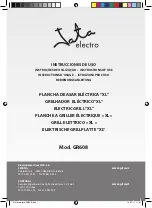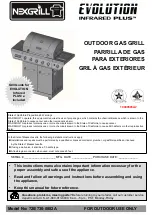
5.OPERATION
EN
•
If the burner does not light after following the procedure above, turn the knobs to the off position. Close the gas
valve on the gas cylinder. Wait five minutes. Repeat the steps above. If the barbecue still does not light, please
refer to the manual lighting instructions below.
•
After lighting, the burners must burn at the maximum position for 3 to 5 minutes to pre-heat the barbecue. This
process must be carried out before each cooking session. The hood must remain open during pre-heating.
•
Once pre-heating is finished, turn all of the burners to low heat to ensure the best cooking results.
•
Open the hood of your barbecue before lighting it. NEVER light your barbecue with the hood closed.
•
Ensure that all of the gas buttons are OFF. Open the gas control valve on the gas cylinder or regulator.
•
Insert a lit match through the rightmost ignition hole below the control panel and place it near the right burner
hole.
•
Push and turn the far right knob anti-clockwise to the maximum position.
•
When the right burner is lit, turn on the remaining burners from right to left.
•
Make sure that each burner is lit before lighting the next burner.
•
If the far right burner does not light, contact your local retailer.
•
After lighting, the burners must burn at the maximum position for 3 to 5 minutes to pre-heat the barbecue. This
process must be carried out before each cooking session. The hood must remain open during pre-heating.
•
Once pre-heating is finished, turn all of the burners to the minimum position to ensure the best cooking results.
•
The stainless steel burners heat the heat diffuser (or the basket with briquettes/lava stone) under the grill, which
in turn heats the food placed on the grill. The natural juices produced by the food during cooking flow over the
heat diffuser (or briquettes/lava stone) and evaporate. The resulting smoke envelops the food, escaping upwards,
giving the food the unique aroma of a barbecue. To obtain a more even cooking, lower the barbecue hood, making
sure the burners are on low heat.
•
The burners directly heat the plate, which cooks the food placed on it. The plates allow you to cook smaller foods,
such as seafood, that could fall between the bars of the grill. They also cook foods that require a high temperature/
short cooking times such as vegetables and small pieces of fish. Similarly, they can be used just like a kitchen
hotplate to grill steaks, cook eggs, etc. They can also be used to heat pans or keep food warm.
•
Flares occur when the food is cooking and the juices and fats run over the hot heat diffusers. Smoke, of course,
helps to give food that great barbecue taste, but it is better to avoid flares to prevent the food from burning. To
control these flares, it is ABSOLUTELY ESSENTIAL to remove the excess fat from the food before cooking. Use a
reasonable amount of marinades and cooking sauces. The burners must also be set to MIN for cooking.
•
When flares occur they can normally be extinguished by putting baking powder or salt directly onto the heat
diffusers. Always protect your hands when working near the barbecue surface, taking care to protect yourself
against flames.
•
In case of a grease fire please follow the instructions below.
Controlling flares *Very Important*
Cooking on the plate
Cooking on the grill
Instructions for manual lighting
4
6
Summary of Contents for KENTON 3276000323594
Page 1: ...KENTON 4 4 KENTON EAN CODE 3276000323594 2022 01 V01 RU KZ EN Assembly Use Maintenance Manual...
Page 3: ...Pages 1 11 Pages 12 15 1 2 Pages 16 18 H 6...
Page 4: ...1 x4 A8 x1 A14 1 1 1 2 x2 A10 PH 6...
Page 5: ...1 3 1 4 2 A1 x1 A2 x1 PH 6 PH 6 A9 x1 C x4...
Page 6: ...3 1 5 1 6 A12 x1 B x4 PH 6 A7 x2 PH 6...
Page 7: ...4 2 1 2 2 C x4 PH 6 B1 x1...
Page 8: ...5 2 3 2 4 C x4 D x4 B3 x2 B4 x2 C x4 PH 6 PH 6...
Page 9: ...6 2 5 2 6 C x4 B14 x2 B2 x2 x4 F PH 6 x6 B6 1 2 1 X2 B14 2...
Page 10: ...7 2 7 2 8 B x1 PH 6 2 1...
Page 11: ...8 2 9 2 10 x1 A5 E x4 A11 x2 B x4 x1 A6 PH 6 PH 6 x2 A11 X2...
Page 12: ...9 2 11 2 12 x2 G...
Page 13: ...10 2 13 2 14 A x2 B9 x1 x1 B12 PH 6...
Page 14: ...11 2 15 B7 x1 x2 B16 x1 B15 x4 B13 2 16...
Page 15: ...4 8 7 12 1 2 3 50 50 5 OFF OFF...
Page 16: ...13 9 10...
Page 17: ...14 12 11...
Page 18: ...13 15...
Page 19: ...1 2 16 3...
Page 20: ...17 6 4 5 6...
Page 21: ...7 18...
Page 22: ...1 RU 1 OFF 2 3 50 50 4 19...
Page 23: ...2 RU 20...
Page 24: ...2 RU 10 C 9 12 ISO 51982 1 5 222 485 13 80 EAC 16 3 21 min max 222mm min max 485 mm 15860 84...
Page 25: ...OFF OFF 50 5 4 22 RU...
Page 26: ...OFF 4 23 RU...
Page 27: ...5 3 5 OFF 3 5 24 RU 1...
Page 28: ...5 OFF 5 OFF 6 25 RU...
Page 29: ...6 26 RU...
Page 30: ...6 27 RU...
Page 31: ...7 80 3 4 80 28 RU...
Page 32: ...8 9 3 2 Naterial Naterial Naterial 29 RU...
Page 34: ...1 1 OFF 2 3 50 50 4 2 KZ 31...
Page 35: ...KZ 32...
Page 37: ...OFF OFF 5 50 OFF 4 4 KZ 34...
Page 38: ...5 3 5 1 OFF 3 5 KZ 35...
Page 39: ...MIN 5 OFF 6 KZ 36...
Page 40: ...KZ 37...
Page 41: ...6 KZ 38...
Page 42: ...KZ 39...
Page 43: ...7 80 3 4 80 KZ 40...







































